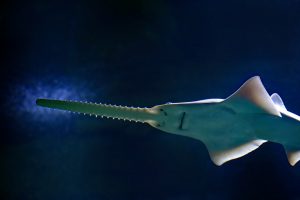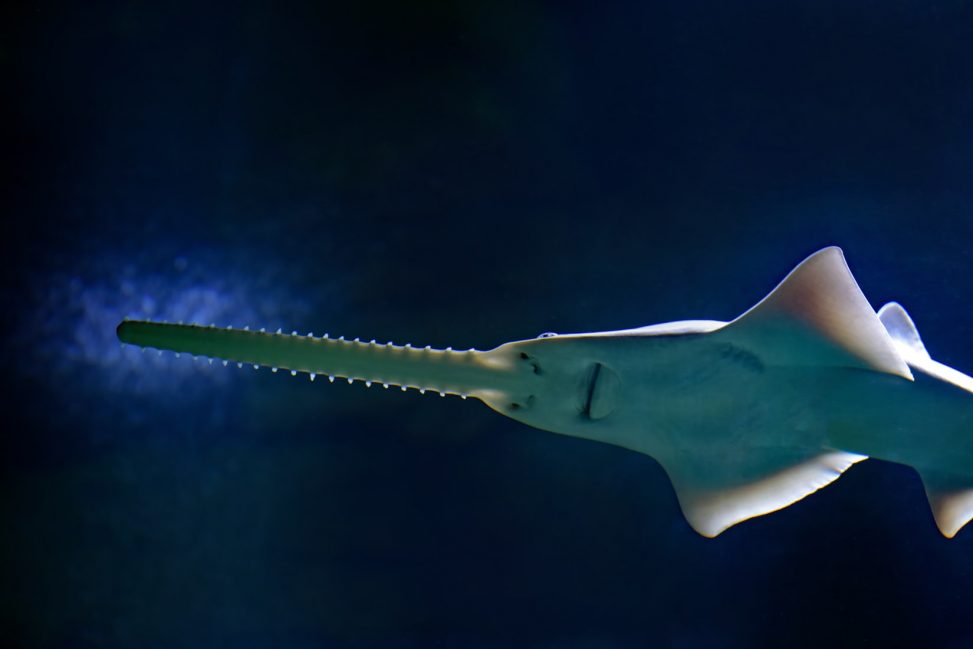What’s a fun family friendly afternoon, educational experience, and conservation operation all-in-one? A day spent wandering a zoo or an aquarium, of course! In a new study, Australian researchers evaluate the benefits and drawbacks of maintaining threatened wildlife displays for purposes of sustainable wildlife tourism, public education, and recreation. When it comes to critically endangered species, the ethical conversation surrounding their display and capture from the wild becomes more complicated. Careful consideration must be given to the drawbacks of removing individuals from the wild in relation to the educational value of their display.

Largetooth Sawfish (Pristis pristis) in captivity at the Cairns Aquarium, Australia.
The largetooth sawfish is a critically endangered species belonging to the elasmobranch (shark and ray) clade. There are four species of sawfish living today, all of which have been listed as critically endangered by the IUCN Red List. Possibly reaching up to 7 meters in length, the sawfish is distinguished by their large saw-like snout, which is used to disturb the seafloor in order to flush and capture prey. This unique appendage also confers increased vulnerability through high susceptibility to accidental capture in fishing nets. Sawfishes are also extremely vulnerable to habitat destruction due to their preference for heavily impacted habitats such as mangroves and seagrass beds.
Sawfishes are widely featured in aquaria across the globe due to their striking appearance and large size, with at least 34 wild-caught individuals being displayed in captivity worldwide. The Australian region holds the most captive sawfishes, and hosts one of very few suitable habitats for wild sawfishes. Due to the fragility of the ecosystem and sawfish population, export of sawfish from Australia to international aquaria was banned in 2011. To combat losses in wild populations, aquaria throughout Australia have adopted educational programs for visitors featuring the sawfish, as well as participating in release programs of their adult sawfish whom are able to be introduced to the wild.
Four major Australian aquaria were involved in this study, which utilized pre-visit and post-visit surveys to quantify the impact of viewing the sawfish exhibit on an individual patron’s behaviors regarding conservation, knowledge of the species, and attitude towards sawfish. Conservation Impact Scores were also used to measure the conservation influence of these diverse exhibits, as well as to evaluate the contribution of each exhibit to global biodiversity conservation.
 At all aquaria studied, exit surveys showed visitors gained significant sawfish-related knowledge and developed more positive attitudes towards sawfish and sawfish conservation. At some aquaria, visitors left having learned about sawfish biology and threats in the wild. Ultimately, results show that the impact of largetooth sawfish displays on real-life conservation benefits is highly project-dependent, but that increased financial support of aquarium-based research and conservation projects has resulted in a greater contribution to the conservation of global biodiversity. Developing specific conservation missions or outcomes for exhibits offers an increased positive impact on conservation as well.
At all aquaria studied, exit surveys showed visitors gained significant sawfish-related knowledge and developed more positive attitudes towards sawfish and sawfish conservation. At some aquaria, visitors left having learned about sawfish biology and threats in the wild. Ultimately, results show that the impact of largetooth sawfish displays on real-life conservation benefits is highly project-dependent, but that increased financial support of aquarium-based research and conservation projects has resulted in a greater contribution to the conservation of global biodiversity. Developing specific conservation missions or outcomes for exhibits offers an increased positive impact on conservation as well.
Ultimately, visitors’ gains in knowledge and positive shifts in attitude towards sawfishes were not translated long-term into behavioral changes that would positively influence sawfish conservation. Instead, it is suggested that “engaging visitors emotionally and providing supporting post-visit resources may promote positive changes in conservation behaviors,” (pp 18). Providing information, souvenirs, or media promoting conservation actions which could be kept by visitors may result in more persistent awareness of sawfish conservation post-visit.
Citations:
Kathryn A. Buckley, Liam D. G Smith, David A. Crook, Richard D. Pillans & Peter M. Kyne (2020): Conservation impact scores identify shortfalls in demonstrating the benefits of threatened wildlife displays in zoos and aquaria, Journal of Sustainable Tourism, DOI: 10.1080/09669582.2020.1715992

Alex
"This title was very eye catching! That is so interesting that such a ..."
Alex
"This is really interesting! The fact that crops and plants are damaged is ..."
Alex
"Well done, this article is great and the information is very captivating! Ethics ..."
Alex
"I was intrigued throughout the whole article! This is such an interesting topic, ..."
Alex
"This is such an interesting article, and very relevant!! Great job at explaining ..."
Grandpa
"Honey You Did a good job I will forward to my eye doctor "
murphymv
"This article is fascinating because it delves into the details of the research ..."
murphymv
"I agree, adding the photo helped solidify the main finding. "
murphymv
"This is a fascinating finding. I hope this innovative approach to improving transplants ..."
Sherzilla
"This is a great article! I would really love to hear how exactly ..."
Sherzilla
"It's disappointment that these treatments were not very effective but hopefully other researchers ..."
Sherzilla
"I agree with your idea that we need to shift our focus to ..."
Sherzilla
"It's amazing to see how such an everyday household product such as ..."
Lauren Kageler
"I will be interested to see what the data looks like from the ..."
Lauren Kageler
"A very interesting article that emphasizes one of the many benefits that the ..."
maricha
"Great post! I had known about the plight of Little Browns, but I ..."
Sherzilla
"I assumed cancer patients were more at risk to the virus but I ..."
Sherzilla
"Great article! It sheds light on a topic that everyone is curious about. ..."
maricha
"This article is full of really important and relevant information! I really liked ..."
maricha
"Definitely a very newsworthy article! Nice job explaining the structure of the virus ..."
maricha
"It's interesting to think that humans aren't only species dealing with the global ..."
murphymv
"This is very interesting and well explained. I am not too familiar with ..."
Lauren Kageler
"Great article! This post is sure to be a useful resource for any ..."
Lauren Kageler
"Definitely seems like an odd pairing at first, but any step forward in ..."
murphymv
"What an interesting article! As you say, height and dementia seem unrelated at ..."
murphymv
"Great article! I learned several new methods of wildlife tracking. This seems like ..."
murphymv
"Very interesting topic! You explained cascade testing and its importance very well. I ..."
Alex
"This article is really interesting! What got me hooked right away was the ..."
Sabrina
"I found this article super interesting! It’s crazy how everyday products can cause ..."
Erin Heeschen
"I love the layout of this article; it's very eyecatching! The advancements of prosthetics ..."
murphymv
"Awesome article! I like the personality in the writing. Flash Graphene not only ..."
murphymv
"Very interesting work! I don't know a whole lot about genetics, but this ..."
Cami Meckley
"I think the idea of using virtual reality technology to better help prepare ..."
Erin Heeschen
"I wonder if there's a connection between tourist season and wildfires in the ..."
Ralph berezan
"Not bad Good work "
Michelle
"This sounds like it would be a great tool for medical students! ..."